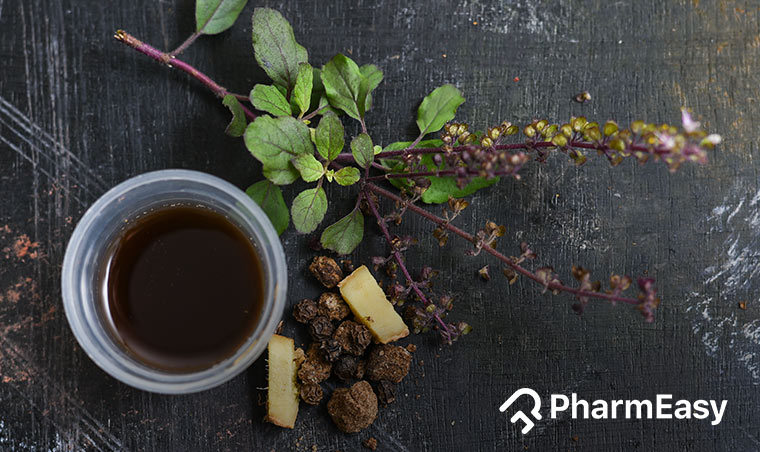Introduction
Ashokarishta is a famous Ayurvedic formulation made from the bark of the Ashoka tree (Saraca asoca)1. In this blog, we’ll discuss the ingredients of Asokarishtam, its method of preparation, various Ashokarishta uses and benefits, how to use it, and its side effects.
Ingredients of Ashokarishta and Their Properties
The major ingredients of Ashokarishta include Water for decoction, Jaggery, and Ashoka (Saraca asoca)3.
- Ashoka: It may have anticarcinogenic (preventing or delaying cancer) and antitumor1
- Bibhitaki: It may have anti-inflammatory properties
- Vasa: It may be antispasmodic (Relieving muscle spasms)
- Mustaka: It may show anti-inflammatory activity
- Amrasthi: It may have potential antitumor properties
- Amalaki: It may have anti-oxidant (preventing cell damage), anti-inflammatory, and immunomodulatory properties
- Nilotpala: It may show analgesic (pain-relieving) and anti-inflammatory properties
- Krishna Jeeraka: It may be anti-spasmodic
- Haritaki: Antioxidant, anticarcinogenic
- Mustaka: It may show anti-inflammatory activity
- Shweta Jeeraka: It may possess antispasmodic and anticarcinogenic properties
- Daruharidra: It may demonstrate antitumor and anti-inflammatory properties
- Dhataki: It may have a potential anti-tumor effect
Did You Know?
- A clinical trial found that the combined treatment of Ashokarishta, Ashwagandha Churna, and Praval Pishti resulted in a significant reduction in menopausal symptoms. source: NCBI
- Ashokarishta acts against dryness of the vagina, joint and muscular discomfort, and gastrointestinal disturbances. source: NCBI
Method of Preparation
Ashoka tree bark is obtained, processed into a decoction, and then combined with other medicinal herbs. This mixture is left to ferment naturally, resulting in the production of Ashokarishta1.
- Prepare the Ashoka Bark: Wash and dry the Ashoka bark, then grind it into a fine powder.
- Make the Decoction: Boil the powdered Ashoka bark in a large quantity of water until a concentrated decoction is obtained.
- Sweetening and Filtration: Transfer the decoction to a glass container and mix in jaggery. Boil the mixture again and then filter it.
- Incorporate Additional Herbs: Grind the other medicinal ingredients into a fine powder and add them to the filtered decoction.
- Fermentation Process: Seal the container with a lid and allow the mixture to ferment at an appropriate temperature for a few days.
- Final Product: Once fermentation is complete, Ashokarishta is ready for use.
Potential Uses of Ashokarishta
In ancient times, the Ashoka tree was believed to have the ability to reduce sorrow. It has been called the “Friend of Women” as it may offer benefits for various health conditions5. Ashoka can be used both internally and externally, depending on the condition. Some potential uses of Ashokarishta include:
Potential Uses of Ashokarishta for Skin
Ashokarishta may enhance skin complexion and protect the body from toxins due to its detoxification properties10. It is also effective in treating acne and dark patches. These potential Ashokarishta benefits are not backed up by sufficient research, so it is advised that you take it only if prescribed by a qualified doctor.
Other Potential Uses of Ashokarishta
- Ashokarishta may function as a uterine tonic and is said to help with heavy bleeding during periods, severe cramps, tiredness and a burning sensation while menstruating, and can be considered a potential Ashokarishta benefit for periods1.
- Ashokarishta may also be effective in reducing inflammation due to its anti-inflammatory characteristics1.
- It may function as a diuretic (expelling excess water from the body through urine) and a detoxifying agent.
- It may also be helpful in arthritis and may possess pain-relieving properties2.
- It may help reduce pain by acting on nerves.
- It may be effective for problems related to digestion.
- Ashoka may have astringent (skin tightening) properties and it may be helpful in bleeding disorders.
- Ashoka may be useful in managing helminthiasis (worm infections).
- It may help to reduce body temperature.
- Ashoka may also help in dysuria and kidney stones.
- Ashoka paste may be applied to the affected area to reduce pain.
Though there are studies that show the potential uses of ashokarishta in various conditions, these are insufficient and there is a need for further studies to establish the true extent of the benefits of ashokarishta on human health.
Did you know that Ashokarishta is a traditional herbal formulation that may help in treating menstrual disorders like leucorrhoea, menorrhagia, and irregular menstruation thus bringing balance and harmony to the female body10.
Dr. Rajeev Singh, BAMS
How to Use Ashokarishta
Ashokarishta is to be taken after a meal along with the same quantity of water1. Your Ayurvedic physician will prescribe you the dosage as per your age and condition. It is essential to get a complete examination and diagnosis of your condition before initiating the treatment.
You may consult your Ayurvedic physician for the form and dosage. In addition, we advise you to not replace or quit your current medications with any herbal preparations made from ashokarishta without talking to a physician or an Ayurvedic doctor.
Ashokarishta has a possible targeted action on the mucosa of the uterus and the gastrointestinal tract. It might be effective in reducing catarrhal (mucous) build-up and inflammation in these areas. When other remedies don’t work, Ashokarishta may help by soothing and supporting the health of the uterus and gastrointestinal tract.
Dr. Smita Barode, B.A.M.S, M.S.
Also Read: Kalmegh: Uses, Benefits, Side Effects, Precautions & More!
Side Effects of Ashokarishta
Generally, Ashokarishta is safer than modern alternatives when taken in recommended doses. However, despite different Asokarishtam uses, an overdose of Ashokarishta may produce side effects like nausea and vomiting9.
Therefore, if you experience any of such side effects, seek immediate medical help from your doctor who has prescribed it to you. They will be the best guide for providing proper treatment to overcome side effects.
Also Read: Kanchanar Guggulu: Benefits, Side Effects, Precautions & More!
Precautions & Warnings When Using Ashokarishta
- Ashokarishta must be avoided if menstrual problems like heavy bleeding and menstrual pain have not shown any improvement.
- Ashokarishta is said to have a cardiotonic action (contraction of the heart muscle to improve blood flow)11. However, it should not be used in cardiac diseases without the doctor’s supervision.
- One must take extra precautions while giving it to children and elderly adults might develop a few harmful reactions in the body.
- Without consulting a doctor, people should not use ashokarishta to self-medicate themselves.
Also Read: Betel Nuts: Uses, Benefits and Side Effects By Dr. Smita Barode
Frequently Asked Questions (FAQs)
Where are Ashoka trees commonly found? In India, the Ashoka tree is extensively found in South India, Orissa, and Assam. Ashoka tree thrives well in tropical places with well-distributed rainfall.
Can Ashokarishta be used for digestion problems? An imbalance of Pitta dosha leads to indigestion (upset stomach). Ashokarishta balances the pitta dosha and thus it may be helpful for indigestion. Consult your doctor for better advice.
Can Ashokarishta be used for piles? Piles or hemorrhoids are swollen blood vessels that can occur inside or around your anus. Ashokarishta is effective in the management of piles due to astringent properties. It provides relief from the burning sensation in piles9. You must contact your health provider for better solutions and prescription according to your conditions.
What are the different formulations obtained from the Ashoka tree?Saraca asoca or Ashoka tree is marketed in different formulations like Ashokarishta, Ashokkwath, flower powder, seed powder, and Ashokghrita8.
References
- Kamini Dhiman et al; Ayurvedic treatment of ovarian cystic mass: A case study. Journal of biological and scientific opinion. 2014, 2(4). Available from: http://www.jbsoweb.com/admin/php/uploads/152_pdf.pdf
- Planet Ayurveda. Ashokarishta (Asokarishtam) Ashokarishta uses, benefits, indications, and dosage. [Internet] Available from: https://www.planetayurveda.com/library/ashokarishta-asokarishtam/
- Planet Ayurveda. Ashoka (saracaasoca) – Properties, benefits, parts used, and dosage. [Internet] Available from: https://www.planetayurveda.com/library/ashoka-saraca-asoca/
- National center for biotechnology information. Ayurvedic management of recurrent abortions due to uterine fibroid. [Internet] Available from: https://www.ncbi.nlm.nih.gov/pmc/articles/PMC5566827/
- AYURLOG: National journal of research in Ayurved science. A clinical study to evaluate the role of kuberaksha and Ashokarishta in the management of PCOS. [Internet] Available from: https://www.ayurlog.com/index.php/ayurlog/article/view/493
- P. Pradhan, L. Joseph, V. Gupta, R. Chulet, H. Arya, R. Verma, A. Bajpai; Saraca asoca (Ashoka): A review. Journal of chemical and pharmaceutical research. 2009, 1(1): 62-71. Available from: https://www.jocpr.com/articles/saraca-asoca-ashoka-a-review.pdf
- National center for biotechnology information. Kingiodendron pinnatum, a pharmacologically effective alternative for Saraca asoca in an Ayurvedic preparation, Ashokarishta. [Internet] Available from: https://www.ncbi.nlm.nih.gov/pmc/articles/PMC5756021/
- Vikaspedia. Saraca asoca. [Internet] Available from: https://vikaspedia.in/agriculture/crop-production/package-of-practices/medicinal-and-aromatic-plants/saraca-asoca
- Jayasri GKT. Ashokarishta: Relieve Menstrual Cramps & Period Pain with Ayurvedic Tonic [Internet]. AVCRI. 2024 [cited 2025 Apr 3]. Available from: https://www.avcri.org/post/ashokarishta-relieve-menstrual-cramps-period-pain-with-ayurvedic-tonic
- JAPR. International Journal of Ayurveda and Pharma Research. IJAPR. No date [cited 2025 Apr 3]. Available from: https://ijapr.in/index.php/ijapr/article/download/2076/1430/
- Clinical efficacy and safety of Ashokarishta, Ashvagandha … [Internet]. ResearchGate. [cited 2025 Apr 3]. Available from: https://www.researchgate.net/publication/318323463_Clinical_Efficacy_and_Safety_of_Ashokarishta_Ashvagandha_Churna_and_Pravala_Pishti_in_the_Management_of_Menopausal_Syndrome_A_Prospective_Open-label_Multicenter_Study
Disclaimer: The information provided here is for educational/awareness purposes only and is not intended to be a substitute for medical treatment by a healthcare professional and should not be relied upon to diagnose or treat any medical condition. The reader should consult a registered medical practitioner to determine the appropriateness of the information and before consuming any medication. PharmEasy does not provide any guarantee or warranty (express or implied) regarding the accuracy, adequacy, completeness, legality, reliability or usefulness of the information; and disclaims any liability arising thereof.
 30
30
 1
1 
























Comments